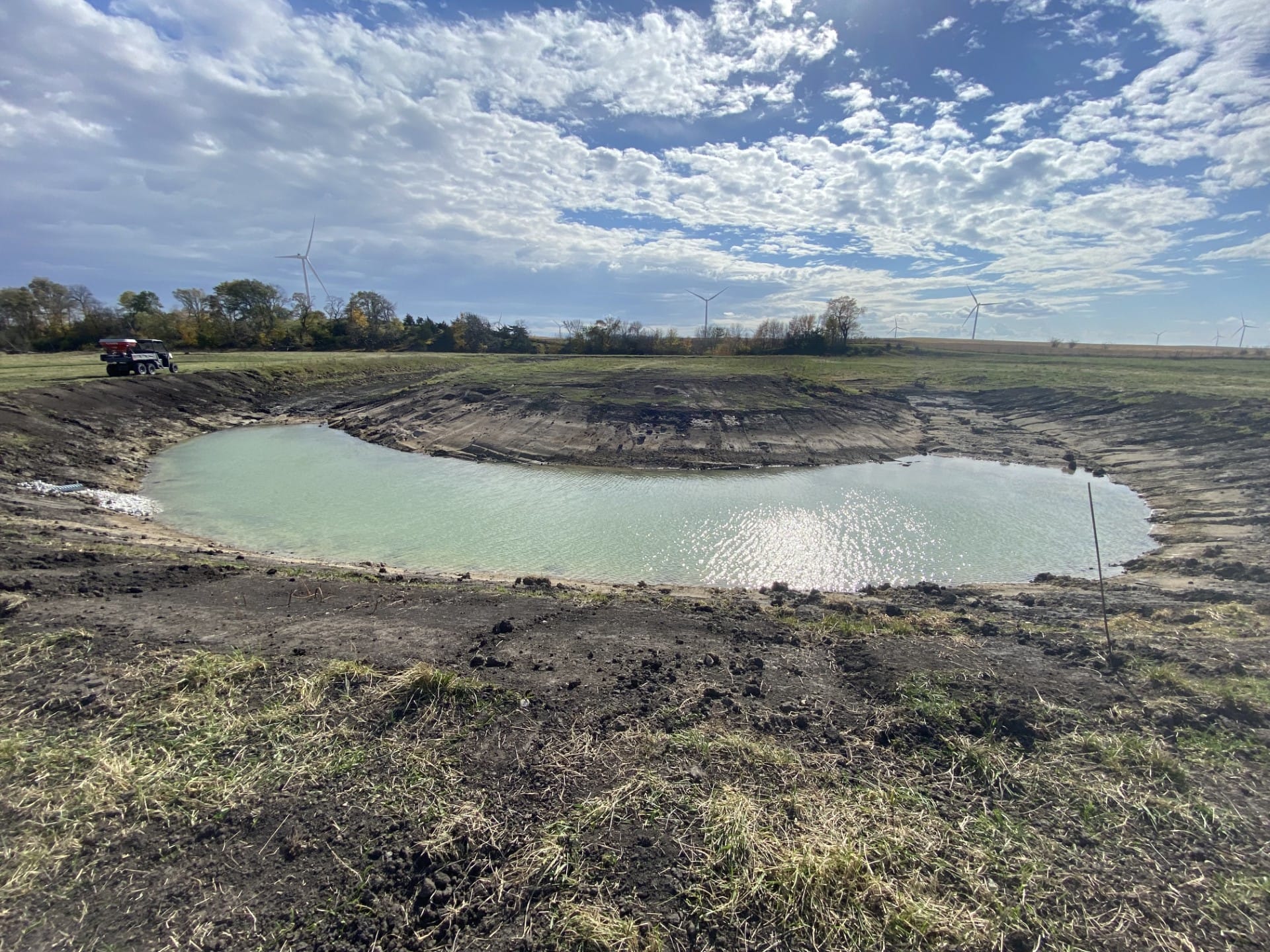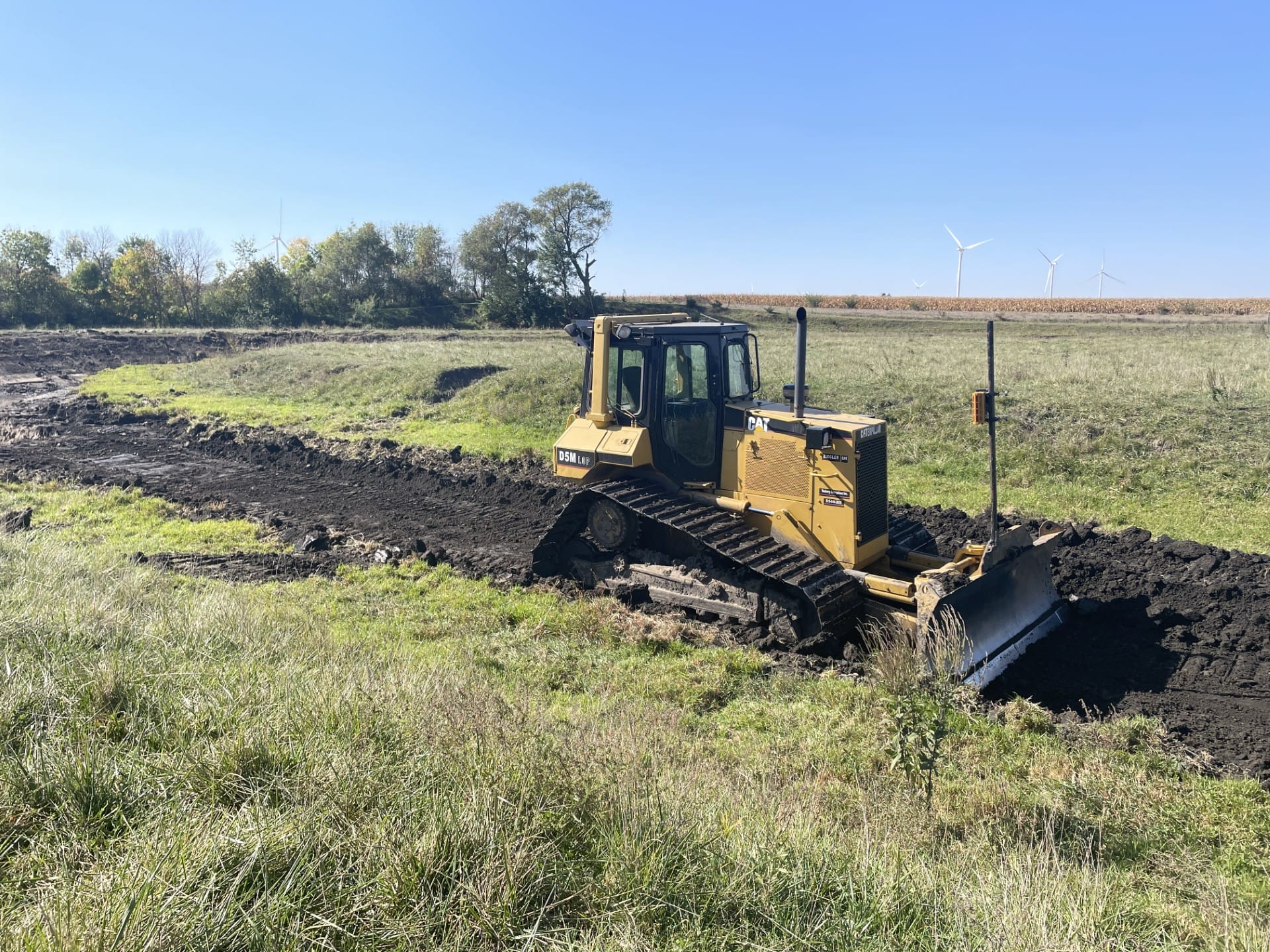PFI and US Fish and Wildlife Partner Together to Restore Oxbows in Iowa
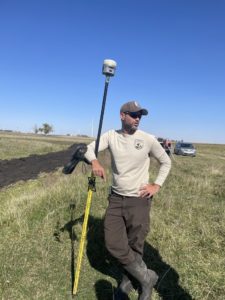
Darrick Weissenfluh of the US Fish and Wildlife is overseeing oxbow development on Linda Evans cattle farm in Greene County, Iowa.
When Darrick Weissenfluh, of the US Fish and Wildlife Service, reached out to Linda Evans late last year about doing an oxbow restoration on her 36-acre pasture area in Greene County, Iowa, she wasn’t sure what to expect.
“Darrick reached out and asked if I was interested in having an oxbow restored on my property,” Linda recalls. “Aerial images of the area showed that multiple oxbows were created by nature, but had filled with sediment, so from a conservation standpoint, restoring them could benefit the water quality of East Buttrick Creek. I said sure, and they’ve [US Fish and Wildlife Service] been great to work with. I think farmers in general do tend to be good stewards of the land, whether it’s cover crops, waterways, or this oxbow restoration. And certainly, the financial incentives were good. There was no expense for me. It just seemed like a win-win proposition.”
Significance and benefits of oxbows in Iowa
Oxbows are former stream meanders that are typically ‘U’ shaped and have become separated from the current stream. They are often referred to as oxbow lakes and are an important type of wetland common in Iowa’s floodplains.
The benefits of oxbows here in Iowa are many. Historically, Iowa was home to shallow meandering prairie streams, many of which have been straightened for ease of farming or transportation. The result is altered and degraded streams and oxbows that are not capable of processing the nutrient runoff from fields quickly enough, resulting in poor water quality. That is one thing that Linda is hoping this oxbow restoration will help with.
“This is ground that East Buttrick Creek runs through on the way down to the Des Moines River,” Linda says. “The large Des Moines metro area has almost 750,000 people who don’t want to drink chemicals and these oxbows are actually filtering nitrates, which I know is a huge concern in recent years as our water quality has gotten more attention. Oxbow restorations are something that farmers are doing or are interested in doing, to help with that issue.”
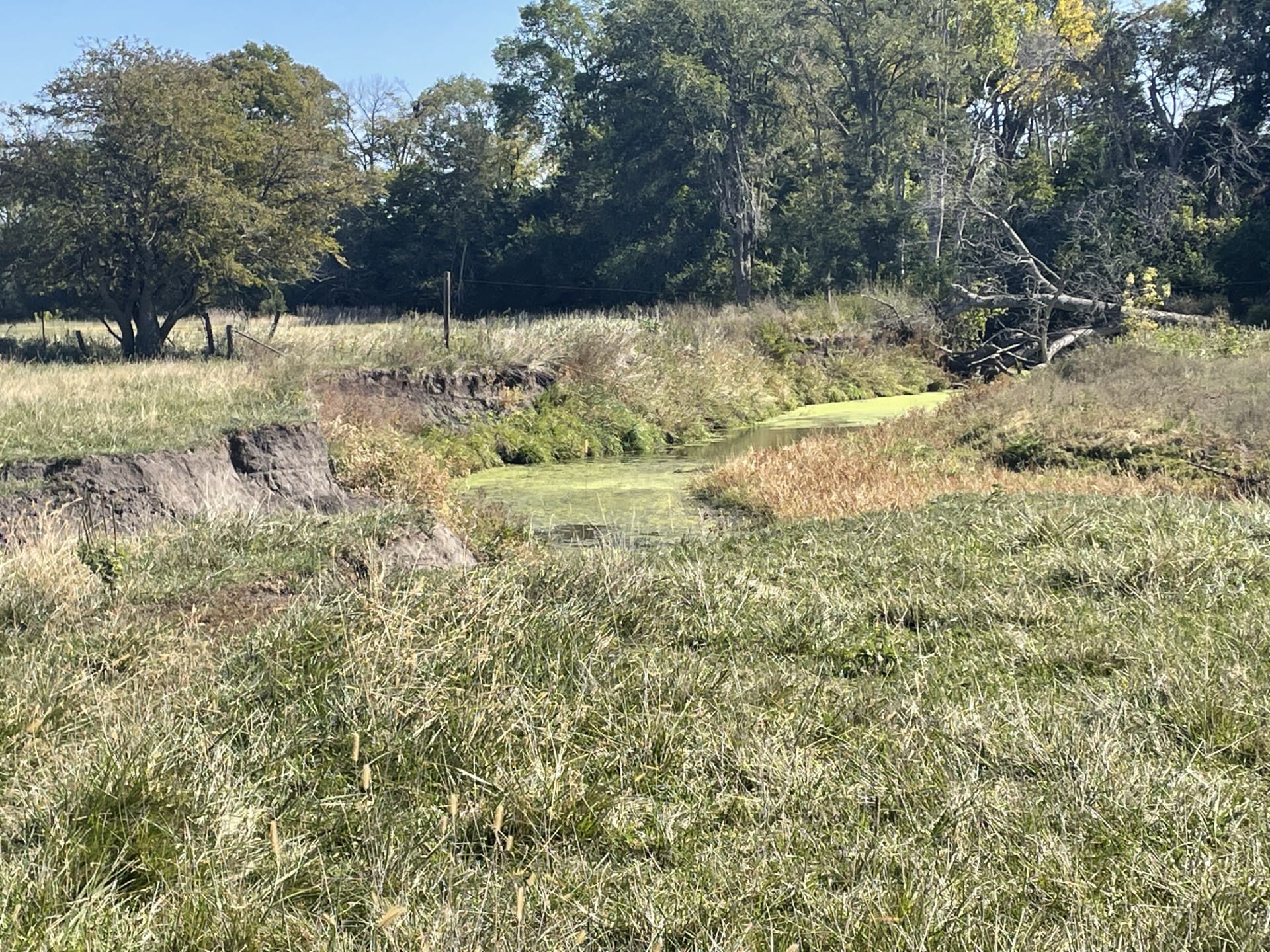
The oxbow will connect with this meandering creek, East Buttrick Creek, which runs to the Des Moines River. Oxbows and other conservation techniques can play a function in purifying the water that supplies the Des Moines metro.
Multi-purpose oxbow restoration
In October 2023, through a partnership with U.S. Fish and Wildlife Service and Practical Farmers of Iowa, using an award from the Iowa Department of Agriculture and Land Stewardship, excavation began to restore two multi-purpose oxbows. When funded by a WQI grant, multi-purpose oxbow restorations are tile-fed to treat crop field drainage water, meaning field tile water is often discharged directly into an oxbow so that restored oxbow wetlands can reduce nitrate levels.
As their name implies, multi-purpose oxbow restorations (and typically all oxbow restorations) can be designed for multiple purposes beyond water quality improvements including fish and wildlife habitat improvement, increasing recreational opportunities, increasing flood water storage, providing off-stream water for cattle and/or improving the viewscape of a farm or property. On the day of my visit, a local contractor was already hard at work restoring a multi-purpose oxbow in the pasture (restoration was recently completed), and another oxbow is now being restored in another pasture to the north.
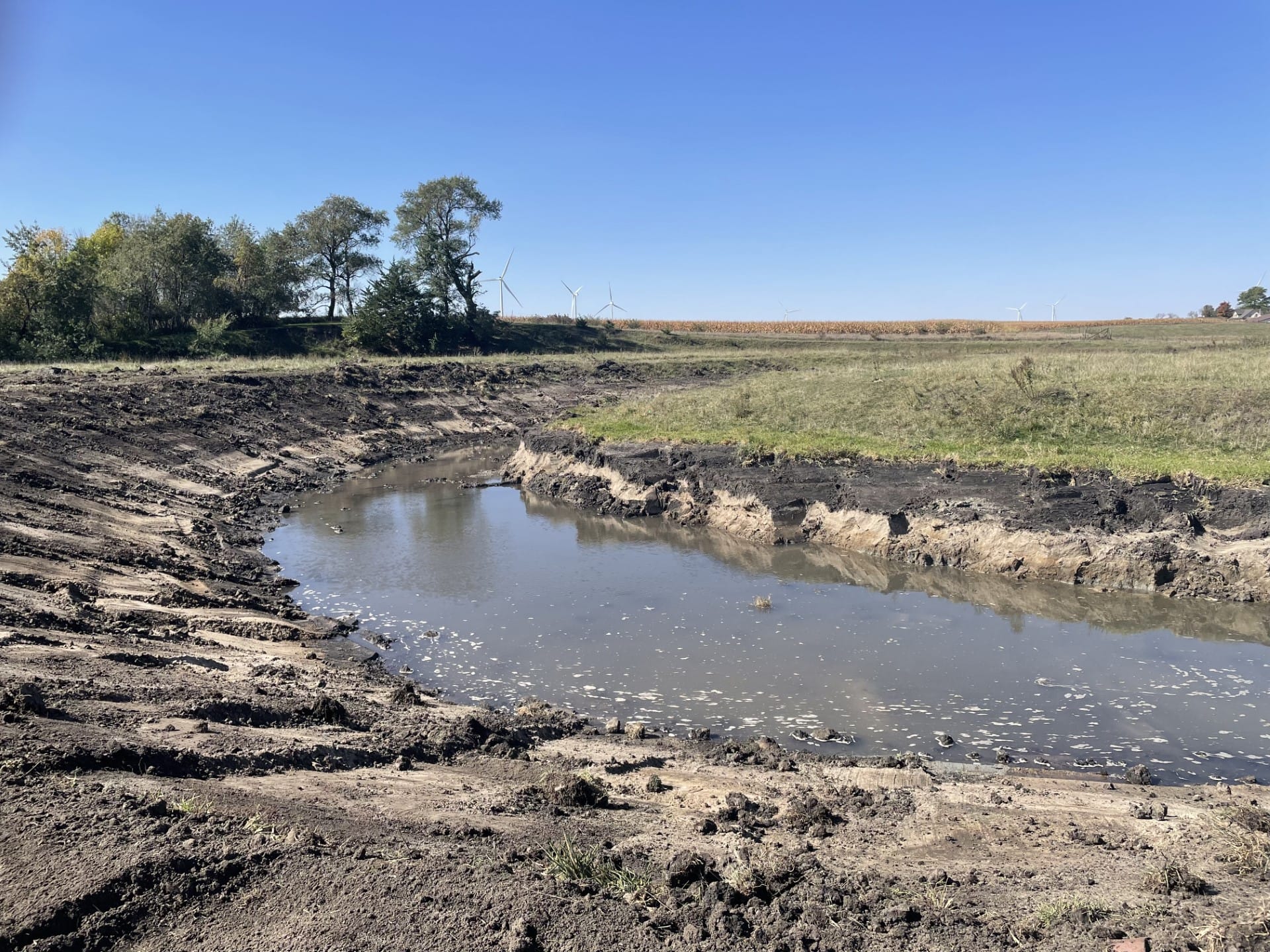
The newly dredged oxbow on Linda Evans cattle farm has tapped groundwater that will assist in connecting the new oxbow to East Buttrick Creek.
Native plant restoration for habitat enhancement
“We started working on this last oxbow a little over a week ago. It really doesn’t take all that long to dig out, and the impact to the landowner is minimal,” says Darrick. “Once we finish digging out the sediment that has accumulated in this oxbow and reconnect the oxbow to the creek, we’ll reseed the banks and disturbance areas with native plants and grasses to provide bank stabilization and habitat for birds and pollinators. All the nutrient-rich soil excavated from the oxbow is being hauled to an adjacent farm field and should result in increased crop yields for the farmer.”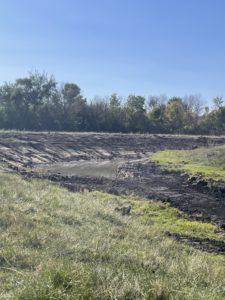
Darrick plans to use a cover crop up to the banks with a native seed mix to stabilize the banks. The pasture is already home to many native species because it has never been plowed or farmed. It is also home to several varieties of non-native clover, and while not native, clover does provide a source of energy and food for wildlife and pollinators such as bees, wasps and butterflies.
Re-seeding with native grasses and deep-rooted prairie mixes adjacent to and along the banks of the oxbows will go a long way in restoring prairie habitat while still allowing for cattle grazing. In the case of Linda’s oxbows, her cattle will essentially fill in the role that native bison once occupied by providing disturbance that native grasses have evolved with, allowing for a more resilient and truer-to-form prairie habitat.
Darrick is hopeful that these restorations, on Evans’ farm, and others will help restore off-stream habitat. These restorations, however, are not meant to restore the river and creeks, just the oxbow wetland functions.
“By removing sediment from the oxbow and reconnecting the oxbow to the original stream channel, we restore that slower ‘pool’ water area that allows for nutrient absorption,” Darrick says. We are also hopeful that it will improve habitat for fish including the Topeka shiner, an endangered species of fish that lives in East Buttrick Creek and other prairie streams in Iowa.”
That potential for habitat, both terrestrial and aquatic, is what Linda most looks forward to with the current restoration.
Looking ahead: Vision of prairie flowers and ecosystem restoration
“I think it’s going to be nice to see fish or birds or butterflies that are maybe supported by the restoration of the oxbows,” Linda says. “One of my most recent chats with Darrick, we spoke about adding prairie flowers. I would love native prairie flowers and I love the idea that this pasture, which has only ever been pasture in my memory, might now contain a little piece of what it was like 100, 200 or more years ago. I think that’s going to be really neat to see out here!”
If you’re interested in learning more about oxbow restoration, please consider attending PFI’s annual conference, specifically the “Roundtable: Overcoming Landscape Challenges to Establish and Maintain Oxbows and Buffers.”

